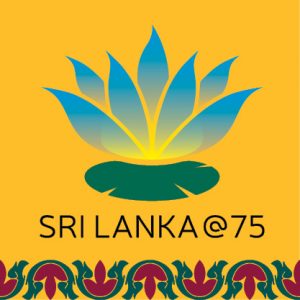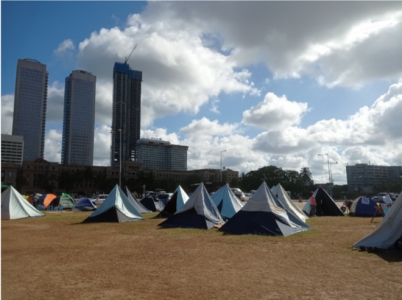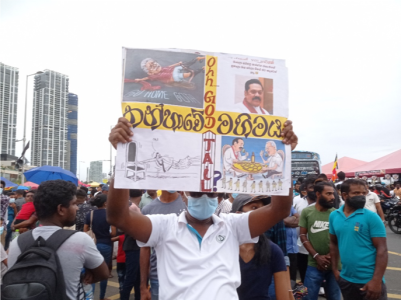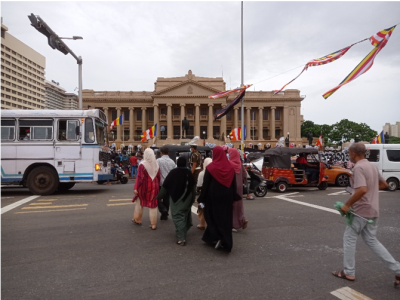 If the dramatic politico-economic collapse, and peoples protests, dominated global headlines about Sri Lanka in 2022, only some information about the internal dynamics of the widespread civic protests has been analysed. Dishani Senaratne examines the nuanced ethnic tensions embedded in what may have been a rare opportunity to bridge historic wounds.
If the dramatic politico-economic collapse, and peoples protests, dominated global headlines about Sri Lanka in 2022, only some information about the internal dynamics of the widespread civic protests has been analysed. Dishani Senaratne examines the nuanced ethnic tensions embedded in what may have been a rare opportunity to bridge historic wounds.
In 2022, Sri Lanka’s foreign exchange reserves plummeted drastically, resulting in acute shortages of fuel, cooking gas, medical supplies and other necessities. In response to perceived sheer mismanagement of the economy by the then government/administration of Gotabaya Rajapaksa, sporadic non-partisan small-scale protests like candlelight vigils mobilised through social networks and messaging Apps were held in Colombo and a few other nearby towns in early March.
The proposal to impose 13-hour power outages provided the initial spark for a large group of protestors to eventually storm the private residence of President Rajapaksa. Three days later, all 26 Cabinet Ministers resigned en masse from their positions, apart from siblings President Gotabaya Rajapaksa and Prime Minister Mahinda Rajapaksa, in a bid to appease mounting public anger manifested through a wave of protests held in Colombo and its suburbs despite the declaration of a countrywide curfew and a state of emergency following the 31 March public protest. Beyond traditional street protests, the hashtag #GoHomeGota gained traction not only in Sri Lanka but across the world, illustrating how social media is used as a tool to help spark social movements in the digital age.
Adjacent to the Presidential Secretariat (the former Parliament building) in Colombo overlooked by the China-funded Colombo Port City under construction, a group of anti-government protestors began to occupy the scenic Galle Face Green (developed by British colonial rulers for recreational purposes) on 9 April, demanding President Gotabaya Rajapaksa’s resignation. Ironically, this site was earlier declared as the Agitation Site by the Gotabaya Rajapaksa administration itself purportedly to allow a designated space for holding protests and demonstrations to reduce inconvenience to the public. Mockingly renamed ‘GotaGoGama’ (‘GGG’: Gota (short for Gotabaya) Go Village) that is suggestive of the demand for President Gotabaya Rajapaksa to step down, this site gradually morphed into a makeshift village housing, inter alia, a community kitchen, medical centre, library, legal aid clinic, international media centre, movie theatre (aptly named ‘Teargas Cinema’, highlighting the continuation of mass protests amid teargas attacks), art gallery, salon, People’s University (a space to engage in discussions) and sanitation facilities. Drawing inspiration from GGG in Colombo, regional small-scale branches of GGG sprung up in different parts of the country (in Kandy, Galle, Negombo and Ampara), amplifying calls for President Gotabaya Rajapaksa’s resignation. Elsewhere, the global Sri Lankan diaspora staged protests in multiple countries across the world to express solidarity with their Sri Lankan counterparts’ disenchantment with the incumbent political dispensation.

Photo 1: Tent-camps at ‘GotaGoGama’ (GGG; lit. ‘Gota Go Home’), April 2022 © Author; please see below for copyright information.
Attracting massive crowds of diverse ethnic and religious backgrounds from various places alongside local residents, GGG in Colombo slowly but steadily became the epicentre of youth-led anti-government protests that was termed the Aragalaya (lit., ‘Struggle’). Aragalaya is likely to assume the same place in the bilingual Lankan lexicon that the subcontinental term Hartal does, referring as it does to the 1953 August mass uprising (a countrywide demonstration of civil disobedience and strike led by Marxist parties to express public dissatisfaction over the rise in cost of living, especially the cost of rice). To distinguish between the terms Hartal and Aragalaya, the former refers to a dramatic spike, an event, whereas the latter is a continuing process. The introduction of the term Aragalaya to everyday discourses is indicative of how it marked a watershed moment in Sri Lanka’s contemporary political landscape.

Photo 2: Protestor holding an anti-government placard © Author; please see below for copyright information.
The absence of a notable leader or central leadership became a hallmark of the Aragalaya, with protestors (mostly youths) claiming to be non-partisan. Later, members of multiple student groups and trade unions affiliated with political parties, among others, formed core groups of protesters. After months-long protests, President Gotabaya Rajapaksa was forced to flee the country, and eventually submitted his resignation via e-mail from Singapore on 14 July. Leaving an indelible mark on an otherwise non-violent protest movement, the burning of the newly appointed Prime Minister Ranil Wickremesinghe’s private residence in a plush neighbourhood in Colombo on 9 July laid bare how protest movements pivot towards violence during critical moments, allegedly instigated by radical political parties promoting vested interests.
*
At a glance, the Aragalaya stands as a symbol of unity and reconciliation. For example, Muslims breaking their fast at GGG during the holy month of Ramazan seemingly displayed the sense of comradeship between the ethnically diverse protestors. But beyond this façade of unity, the Aragalaya was underpinned by exclusionary Sinhala Buddhist nationalist sentiments played out through a wide array of phenomena — ranging from the ubiquitous presence of the national flag to the practice of singing songs praising Sinhala Buddhist nationalism during the protests. The minimal presence of Tamil voices, aspirations and grievances at the Aragalaya is further proof of its Sinhala Buddhist nationalist underpinnings. In other words, the Aragalaya was a microcosm of the wider Sri Lankan society that is founded on, shaped and influenced by hegemonic Sinhala Buddhist ideologies. These dynamics, by no means, are isolated occurrences.
The roots of Sinhala Buddhist nationalism could be traced back to British colonial rule during which conflicts emerged between the Sinhalese and Tamils due to discriminatory colonial polices. Following independence in 1948, discriminatory Sinhala Buddhist nationalist ideologies continued to be embedded in state policy, evidenced by the swift implementation of the 1956 Sinhala Only Bill that declared Sinhala as the exclusive official language while ousting the Tamil language.

Photo 3: A group of women wearing hijab are crossing the street opposite the Presidential Secretariat to join the protests while Buddhist flags are seen hung, May 2022 © Author; please see below for copyright information.
On the other hand, the Aragalaya allegedly relied on Non-Governmental Organisations (NGOs) for funding to advance anti-Sinhala Buddhist agenda, according to detractors. The supposed NGO move of hanging black Vesak lanterns (which was later removed) as a mark of protest (as opposed to traditional white/colourful lanterns made to celebrate Vesak (the birth, enlightenment and death of the Buddha)) in and around GGG drew flak from Sinhala Buddhist nationalist quarters for disrespecting Buddhist values. Commenting on prevalent anti-NGO sentiments, DeVotta (2007) noted that those who disagree with the Sinhala Buddhist nationalist agenda are attacked as enemies of the state. Along this vein, the portrayal of the Aragalaya as an anti-Sinhala Buddhist exercise was a strategy to dissuade the Sinhalese community from joining its cause, even if, ironically, the Aragalaya emerged from the Sinhalese Buddhist constituency who themselves overwhelmingly voted for Gotabaya Rajapaksa to power in 2019. Marking a departure from their practice of standing in solidarity with successive Rajapaksa governments, the sangha played a key role in mobilising Sinhalese support for the Aragalaya, possibly having discerned the national mood against the Rajapaksa family. Significantly, the fall of the seemingly invincible Rajapaksa family does not necessarily entail the decline of Sinhala Buddhist nationalism.
Amid the deepening economic and political crises, a silver lining emerged during the protests. The Aragalaya became a launch pad for initiating spaces for alternate views, debate and dissent to reconfigure, redefine and reshape Sri Lankan’s polity and politics. The holding of two separate events on 18 May 2022 by two groups to remember and mourn those who died, were killed or disappeared in the civil war (which ended in 2009) was a case in point. But this sense of tolerance proved fleeting and failed to bridge historic hostilities of legacies of a violent past. Earlier this year, against the larger backdrop of then impending local polls, the incumbent government proposal to fully implement the 13th Amendment to the Constitution — aimed at giving more autonomy to provinces, especially in police and land powers — to win Tamil support triggered protests from Sinhala Buddhist nationalist quarters that epitomised fear-mongering about potential solutions to address Tamil grievances. Amid ongoing violent crackdown on political dissent, the moment of promise of the Aragalaya is increasingly appearing to be yet another wasted opportunity.
*
The views expressed here are those of the author and do not represent the views of the ‘South Asia @ LSE’ blog, the LSE South Asia Centre or the London School of Economics and Political Science. Please click here for our Comments Policy.
Photographs © Dishani Senaratne; no photograph may be used/reproduced without written permission of the author.
This blogpost may not be reposted by anyone without prior written consent of LSE South Asia Centre; please e-mail southasia@lse.ac.uk for permission.
Banner image © Author, ‘Protestors waving the National Flag at the Aragalaya’, May 2022.
The ‘Sri Lanka @ 75’ logo is copyrighted by the LSE South Asia Centre, and may not be used by anyone for any purpose. It shows the national flower of Sri Lanka, the Water Lily (Nymphaeaceae), framed in a graphic design of colours derived from the national flag, and sacral architectural motifs. The logo has been designed by Oroon Das.
*








Exactly.
Thank you, Dishani for w
riting this.
I disagree on this except in one that its failure is due to not having one clear leadership. The Rajapaksas were the epitome of Sinhala Buddhist nationalism or they acted as such. In such a case sinhala Buddhist nationalists against the Rajapaksas is an impossibility. Aragalaya was begun by a Catholic priest representing the diocese of Ratnapura. As usual in any country its the majority ethnicity that takes the lead in protests. The csuse of economic decline affected all but there were muslims with a grudge against Rajapaksas for not allowing burials during COVID and Tamil nationalists whose terrorist leader was assassinated during Rajapaksas period of power. Further the lead was taken by Marxist groups but it becsme a middle class causes representing agitation demanding uninterrupted electricity supply and fuel at any price. American NGO such as national endowment for democracy partly funded this hoping that pro China Rajapaksas could be ousted via a colour revolution.